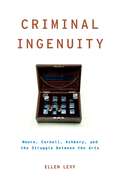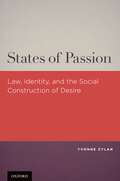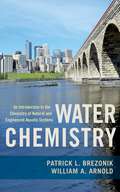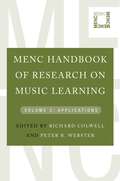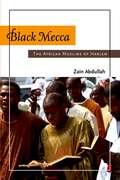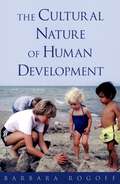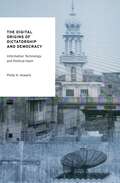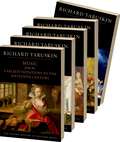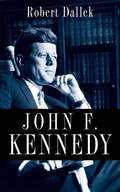- Table View
- List View
The Economist's Oath: On the Need for and Content of Professional Economic Ethics
by George F. DeMartinoEconomics is today among the most influential of all professions. Economists alter the course of economic affairs and deeply affect the lives of current and future generations. Yet, virtually alone among the major professions, economics lacks a body of professional ethics to guide its practitioners. Over the past century the profession consistently has refused to adopt or even explore professional economic ethics. As a consequence, economists are largely unprepared for the ethical challenges they face in their work. The Economist's Oath challenges the economic orthodoxy. It builds the case for professional economic ethics step by step-first by rebutting economists' arguments against and then by building an escalating positive case for professional economic ethics. The book surveys what economists do and demonstrates that their work is ethically fraught. It explores the principles, questions, and debates that inform professional ethics in other fields, and identifies the lessons that economics can take from the best established bodies of professional ethics. George DeMartino demonstrates that in the absence of professional ethics, well-meaning economists have committed basic, preventable ethical errors that have caused severe harm for societies across the globe. The book investigates the reforms in economic education that would be necessary to recognize professional ethical obligations, and concludes with the Economist's Oath, drawing on the book's central insights and highlighting the virtues that are required of the "ethical economist." The Economist's Oath seeks to initiate a serious conversation among economists about the ethical content of their work. It examines the ethical entailments of the immense influence over the lives of others that the economics profession now enjoys, and proposes a framework for the new field of professional economic ethics.
Sleep and Development: Familial and Socio-Cultural Considerations
by Mona El-SheikhSleep problems of American children have become a matter of national concern, with recent estimates indicating that 13% to 27% of children have sleep problems as reported by their parents. Considering the profound impact that disrupted sleep can have on family functioning and processes, it is critical that researchers and clinicians understand how to identify sources and contexts related to sleep disruptions and their consequences. Sleep and Development: Familial and Socio-Cultural Considerations is the first volume to integrate knowledge and approaches from numerous disciplines to focus on the sleep and development of children across adjustment and cognitive domains. Addressing the sleep patterns of children as well as those of other family members, sleep specialists from pediatrics, human development, family studies, and developmental and clinical psychology examine linkages between sleep and family processes, cultural attitudes towards sleep, and normative sleep disturbances in children, such as resistance to bedtime, chronic deprivation, and inconsistent sleep schedules. Individual chapters offer discussion on topics such as sleep and attachment, the effects of trauma on children's sleep, the cultural ecology of sleep, clinical assessment of sleep, and more. Highlighting research findings obtained within the last ten years, Sleep and Development synthesizes literature from disparate areas of inquiry in an effort to frame future investigations that will lead to a deeper and better integrated understanding of sleep and development. This comprehensive volume is a fundamental text for students, researchers, psychologists, and physicians interested in the study of sleep and sleep problems.
Public Goods, Public Gains: Calculating the Social Benefits of Public R&D
by Albert N. Link John T. ScottIn Public Goods, Public Gains, Link and Scott discuss the systematic application of alternative evaluation methods to estimate the social benefits of publicly financed research and development (R&D). The authors argue that economic theory should be the guiding criterion for any method of program evaluation because it focuses attention on the value and the opportunity costs of the program. The evaluation methods discussed and illustrated are both economics and, for comparison, non-economics based. The book is motivated by four foundation chapters that discuss government's role in innovation from the perspective of economic theory, review public accountability issues from both a constitutional and an historical perspective, overview systematic approaches to program evaluation, and describe the evaluation metrics typically used. Four case studies illustrate the four alternative evaluation approaches discussed. These case studies are for the U.S. Advanced Technology Program's intramural research awards program, the U.S. National Institute of Standards and Technology's research on wavelength references for optical fiber communications, the U.S. Malcolm Baldrige National Quality Award, and the Advanced Technology Program's focused program on the integration of manufacturing applications.
Criminal Ingenuity: Moore, Cornell, Ashbery, and the Struggle Between the Arts (Modernist Literature and Culture)
by Ellen Levy"Poetry was declining/ Painting advancing/ we were complaining/ it was '50," recalled poet Frank O'Hara in 1957. Criminal Ingenuity traces a series of linked moments in the history of this transfer of cultural power from the sphere of the word to that of the image. Ellen Levy explores the New York literary and art worlds in the years that bracket O'Hara's lament through close readings of the works and careers of poets Marianne Moore and John Ashbery and assemblage artist Joseph Cornell. In the course of these readings, Levy discusses such topics as the American debates around surrealism, the function of the "token woman" in artistic canons, and the role of the New York City Ballet in the development of mid-century modernism, and situates her central figures in relation to such colleagues and contemporaries as O'Hara, T. S. Eliot, Clement Greenberg, Walter Benjamin, and Lincoln Kirstein. Moore, Cornell, and Ashbery are connected by acquaintance and affinity-and above all, by the possession of what Moore calls "criminal ingenuity," a talent for situating themselves on the fault lines that fissure the realms of art, sexuality, and politics. As we consider their lives and works, Levy shows, the seemingly specialized question of the source and meaning of the struggle for power between art forms inexorably opens out to broader questions about social and artistic institutions and forces: the academy and the museum, professionalism and the market, and that institution of institutions, marriage.
States of Passion: Law, Identity, and Social Construction of Desire
by Yvonne ZylanIn States of Passion: Law, Identity and the Social Construction of Desire, Professor Yvonne Zylan explores the role of legal discourse in shaping sexual experience, sexual expression, and sexual identity. The book focuses on three topics: anti-gay hate crime laws, same-sex sexual harassment, and same-sex marriage, examining how sexuality is socially constructed through the institutionally-specific production of legal discourse. States of Passion argues that law's power to authorize specific discourses and practices of love, desire, hatred, fear, and vulnerability remain grounded in the powerful discourses and institutional practices that mark law as dispassionate, cerebral, and fundamentally procedural. States of Passion contends that those states of passion we experience in our daily lives as particularly significant-to our sense of self, to our collective and social identities, and to our ideas about the body and its dictates-increasingly have as much to do with the state as they do with passion.
Creation without Restraint: Promoting Liberty and Rivalry in Innovation
by Christina Bohannan Herbert HovenkampCreation without Restraint: Promoting Liberty and Rivalry in Innovation analyzes the current state of competition (antitrust) and intellectual property laws, and proposes realistic reforms that will encourage innovation. As with antitrust and a reform process that aligned injury requirements in lawsuits with the incentive to compete, this book proposes similar reforms for patent and copyright law, and considers both the uses and limitations of antitrust as a vehicle for intellectual property law reform.
Exploratory Factor Analysis (Understanding Statistics)
by Leandre R. Fabrigar Duane T. WegenerExploratory Factor Analysis (EFA) has played a major role in research conducted in the social sciences for more than 100 years, dating back to the pioneering work of Spearman on mental abilities. Since that time, EFA has become one of the most commonly used quantitative methods in many of the social sciences, including psychology, business, sociology, education, political science, and communications. To a lesser extent, it has also been utilized within the physical and biological sciences. Despite its long and widespread usage in many domains, numerous aspects of the underlying theory and application of EFA are poorly understood by researchers. Indeed, perhaps no widely used quantitative method requires more decisions on the part of a researcher and offers as wide an array of procedural options as EFA does. This book provides a non-mathematical introduction to the underlying theory of EFA and reviews the key decisions that must be made in its implementation. Among the issues discussed are the use of confirmatory versus exploratory factor analysis, the use of principal components analysis versus common factor analysis, procedures for determining the appropriate number of factors, and methods for rotating factor solutions. Explanations and illustrations of the application of different factor analytic procedures are provided for analyses using common statistical packages (SPSS and SAS), as well as a free package available on the web (Comprehensive Exploratory Factor Analysis). In addition, practical instructions are provided for conducting a number of useful factor analytic procedures not included in the statistical packages.
Treating Impulse Control Disorders: A Cognitive-Behavioral Therapy Program, Therapist Guide (Treatments That Work)
by Jon E. Grant Christopher B. Donahue Brian L. OdlaugImpulse control disorders (ICDs) include pathological gambling, kleptomania, trichotillomania, intermittent explosive disorder, and pyromania, and are characterized by difficulties resisting urges to engage in behaviors that are excessive or ultimately harmful to oneself or others. ICDs are relatively common among adolescents and adults, carry significant morbidity and mortality, and can be effectively treated with behavioral and pharmacological therapies. This guide includes all the information and materials necessary to implement a successful cognitive behavioral therapy program for impulse control disorders (CBT-ICD). This evidence-based intervention was developed for the treatment of pathological gambling, kleptomania, compulsive buying, and pyromania. Originators of interventions for impulse control disorders, the authors review the background and diagnostic information for each ICD as well as available treatment outcome studies; the assessment process for each ICD problem and the individual therapy sessions are also reviewed. This format affords you the flexibility to treat one or more ICD problem, and since they co-occur, this approach is essential. This therapist guide and its corresponding workbook form a complete treatment package. It is a resource that no clinician specializing in these disorders can do without.
Water Chemistry: An Introduction to the Chemistry of Natural and Engineered Aquatic Systems
by Patrick Brezonik William ArnoldWater Chemistry provides students with the tools necessary to understand the processes that control the chemical species present in waters of both natural and engineered systems. After providing basic information about water itself and the chemical composition of water in environmental systems, the text covers the necessary theory (thermodynamics, activity, and kinetics) and background material to solve problems. It emphasizes that both equilibrium and kinetic processes are important in aquatic systems. The book does not merely focus on inorganic constituents, but also on the fate and reactions of organic chemicals. The solving of quantitative equilibrium and kinetic problems using mathematical, graphical, and computational tools is emphasized throughout presentations on acid-base chemistry, complexation of metal ions, solubility of minerals, and oxidation-reduction reactions. The use of these problem-solving tools is then extended in the presentation of topics relevant to natural systems, including dissolved oxygen, nutrient chemistry, geochemical controls on chemical composition, photochemistry, and natural organic matter. The kinetics and equilibria relevant to engineered systems (e.g., chlorination and disinfection chemistry, sorption and surface chemistry) and organic contaminant chemistry are also discussed. Numerous in-chapter examples that show the application of theory and demonstrate how problems are solved using algebraic, graphical, and computer-based techniques are included. Examples are relevant to both natural waters and engineered systems.
Justice Perverted: Sex Offense Law, Psychology, and Public Policy
by Charles Patrick EwingOver the past quarter century Congress, state legislatures and the courts have radically reshaped America's laws dealing with sex offenders in an effort to reduce the prevalence of sex offenses. Most convicted sex offenders must now register with the authorities, who then make information about them available to the public. Possession of child pornography has been made an extremely serious crime often punishable by prison sentences that dwarf those meted out to child molesters, rapists, robbers, and even killers. Federal law now imposes a minimum sentence of ten years in prison for those convicted of using the internet to attempt to lure minors for sex. And the federal government and 20 states have "sexually violent predator" laws that allow the indefinite civil commitment of convicted sex offenders to secure institutions for treatment after they have served their full criminal sentences. All of these changes in sex offender law, as well as numerous others, have been based at least in part on input from psychology, psychiatry and the social sciences. Moreover, enforcement and administration of many of these laws relies to a large extent on the efforts of mental health professionals. However, many questions about this involvement remain largely unanswered. Are these laws supported by empirical evidence, or even by well-reasoned psychological theories? Do these laws actually work? Are mental health professionals capable of reliably determining an offender's future behavior, and how best to manage it? Finally, are experts capable of providing effective treatment for sex offenders -- i.e., treatment that actually reduces the likelihood that an identified sex offender will re-offend? In Justice Perverted, Charles Patrick Ewing poses these difficult questions and others that few in either law or psychology have asked, much less tried to answer. Drawing on research from across the social and behavioral sciences, he weighs the evidence for the spectrum of sex offense laws, to occasionally surprising results. A rational look at an intensely emotional subject, Justice Perverted is an essential book for anyone interested in the science behind public practice.
Rheumatoid Arthritis (Oxford American Rheumatology Library)
by Michael H. WeismanRheumatoid arthritis is a common but often debilitating disorder. Given the intricate and challenging nature of treating rheumatoid arthritis, it is imperative to educate physicians on the disease's initial symptoms and complications, as well as to provide accurate and up-to-date information regarding effective treatment. Designed to help eradicate misconceptions concerning rheumatoid arthritis and its treatment, this concise volume helps clinicians to understand and then effectively diagnose and treat patients with the condition. Part of the Oxford American Rheumatology Library, this concise guide serves as a practical, user-friendly reference for rheumatologists and other healthcare professionals. The book provides an overview of rheumatoid arthritis, including its epidemiology, symptoms, signs, and pathophysiology. Using the most current information available, the author evaluates both traditional and innovative treatment methods. A thorough glossary defines key terms and the appendix includes related resource information - associations, journals and doctors/researchers - all devoted to the study and treatment of rheumatoid arthritis.
Debating the Ethics of Immigration: Is There a Right to Exclude? (Debating Ethics)
by Christopher Heath Wellman Phillip ColeDo states have the right to prevent potential immigrants from crossing their borders, or should people have the freedom to migrate and settle wherever they wish? Christopher Heath Wellman and Phillip Cole develop and defend opposing answers to this timely and important question. Appealing to the right to freedom of association, Wellman contends that legitimate states have broad discretion to exclude potential immigrants, even those who desperately seek to enter. Against this, Cole argues that the commitment to the moral equality of all human beings - which legitimate states can be expected to hold - means national borders must be open: equal respect requires equal access, both to territory and membership; and that the idea of open borders is less radical than it seems when we consider how many territorial and community boundaries have this open nature. In addition to engaging with each other's arguments, Wellman and Cole address a range of central questions and prominent positions on this topic. The authors therefore provide a critical overview of the major contributions to the ethics of migration, as well as developing original, provocative positions of their own.
MENC Handbook of Research on Music Learning: Volume 2: Applications
The MENC Handbook of Research on Music Learning, Volume 2: Applications brings together the best and most current research on best practice for music learning, focusing squarely on the profession's empirical and conceptual knowledge of how students gain competence in music at various ages and in different contexts. The collection of chapters, written by the foremost figures active in the field, addresses a range of best practices for approaching current and important areas in the field, including cognition and perception, music listening, vocal/choral learning, and the needs of special learners. The book's companion volume, Strategies, provides the solid theoretical framework and extensive research upon which these practices stand. Throughout both volumes in this essential set, focus is placed on the musical knowledge and musical skills needed to perform, create, understand, reflect on, enjoy, value, and respond to music. A key point of emphasis rests on the relationship between music learning and finding meaning in music, and as music technology plays an increasingly important role in learning today, chapters move beyond exclusively formal classroom instruction into other forms of systematic learning and informal instruction. Either individually or paired with its companion Volume 1: Strategies, this indispensable overview of this growing area of inquiry will appeal to students and scholars in Music Education, as well as front-line music educators in the classroom.
Oxford American Mini-Handbook of Gastrointestinal Cancers
by Gary H. LymanThe therapeutic landscape in oncology has undergone momentous changes in recent years. The treatment options for gastrointestinal (GI) cancers, in particular, have increased with the introduction of novel pharmacological and other treatment modalities. Researchers have gleaned important insights into the molecular biology, pathophysiology and key features of the most prevalent GI cancers, including colorectal, pancreatic and liver. While these advances have resulted in improvements for many GI cancer patients, the emerging complexities and challenges have necessitated the revision of major U.S. and international staging, diagnosis, and treatment guidelines for GI cancers. Part of the Oxford American Mini-Handbook series, this concise yet comprehensive volume provides oncologists and other healthcare professionals with essential, evidence-based guidance on the diagnosis and treatment of all major GI malignancies, including colorectal, pancreatic, liver and esophageal cancers. SERIES OVERVIEW The Oxford American Mini-Handbooks are a series of concisely-formatted adaptations of Oxford American Handbooks. They provide a focused and succinct summary on a specific area of a particular discipline, serving as a portable, easily accessible resource at the point of care. These smaller volumes capture the essentials of assessment and treatment in an exceptionally affordable and more clinically relevant format. Featuring useful tables and bulleted lists, these books provide a readily available resource to specialists and general practitioners alike.
Black Mecca: The African Muslims of Harlem
by Zain AbdullahThe changes to U.S. immigration law that were instituted in 1965 have led to an influx of West African immigrants to New York, creating an enclave Harlem residents now call ''Little Africa.'' These immigrants are immediately recognizable as African in their wide-sleeved robes and tasseled hats, but most native-born members of the community are unaware of the crucial role Islam plays in immigrants' lives. Zain Abdullah takes us inside the lives of these new immigrants and shows how they deal with being a double minority in a country where both blacks and Muslims are stigmatized. Dealing with this dual identity, Abdullah discovers, is extraordinarily complex. Some longtime residents embrace these immigrants and see their arrival as an opportunity to reclaim their African heritage, while others see the immigrants as scornful invaders. In turn, African immigrants often take a particularly harsh view of their new neighbors, buying into the worst stereotypes about American-born blacks being lazy and incorrigible. And while there has long been a large Muslim presence in Harlem, and residents often see Islam as a force for social good, African-born Muslims see their Islamic identity disregarded by most of their neighbors. Abdullah weaves together the stories of these African Muslims to paint a fascinating portrait of a community's efforts to carve out space for itself in a new country.
The Cultural Nature of Human Development
by Barbara RogoffThree-year-old Kwara'ae children in Oceania act as caregivers of their younger siblings, but in the UK, it is an offense to leave a child under age 14 ears without adult supervision. In the Efe community in Zaire, infants routinely use machetes with safety and some skill, although U.S. middle-class adults often do not trust young children with knives. What explains these marked differences in the capabilities of these children? Until recently, traditional understandings of human development held that a child's development is universal and that children have characteristics and skills that develop independently of cultural processes. Barbara Rogoff argues, however, that human development must be understood as a cultural process, not simply a biological or psychological one. Individuals develop as members of a community, and their development can only be fully understood by examining the practices and circumstances of their communities.
The Digital Origins of Dictatorship and Democracy: Information Technology and Political Islam (Oxford Studies in Digital Politics)
by Philip N. HowardAround the developing world, political leaders face a dilemma: the very information and communication technologies that boost economic fortunes also undermine power structures. Globally, one in ten internet users is a Muslim living in a populous Muslim community. In these countries, young people are developing political identities online, and digital technologies are helping civil society build systems of political communication independent of the state and beyond easy manipulation by cultural or religious elites. With unique data on patterns of media ownership and technology use, The Digital Origins of Dictatorship and Democracy demonstrates how, since the mid-1990s, information technologies have had a role in political transformation. Democratic revolutions are not caused by new information technologies. But in the Muslim world, democratization is no longer possible without them.
A More Perfect Military: How the Constitution Can Make Our Military Stronger
by Diane H. MazurSurveys show that the all-volunteer military is our most respected and trusted institution, but over the last thirty-five years it has grown estranged from civilian society. Without a draft, imperfect as it was, the military is no longer as representative of civilian society. Fewer people accept the obligation for military service, and a larger number lack the knowledge to be engaged participants in civilian control of the military. The end of the draft, however, is not the most important reason we have a significant civil-military gap today. A More Perfect Military explains how the Supreme Court used the cultural division of the Vietnam era to change the nature of our civil-military relations. The Supreme Court describes itself as a strong supporter of the military and its distinctive culture, but in the all-volunteer era, its decisions have consistently undermined the military's traditional relationship to law and the Constitution. Most people would never suspect there was anything wrong, but our civil-military relations are now as constitutionally fragile as they have ever been. A More Perfect Military is a bracingly candid assessment of the military's constitutional health. It crosses ideological and political boundaries and is challenging-even unsettling-to both liberal and conservative views. It is written for those who believe the military may be slipping away from our common national experience. This book is the blueprint for a new national conversation about military service.
Oxford History of Western Music: 5-vol. set
by Richard TaruskinThe Oxford History of Western Music is a magisterial survey of the traditions of Western music by one of the most prominent and provocative musicologists of our time. This text illuminates, through a representative sampling of masterworks, those themes, styles, and currents that give shape and direction to each musical age. Taking a critical perspective, this text sets the details of music, the chronological sweep of figures, works, and musical ideas, within the larger context of world affairs and cultural history. Written by an authoritative, opinionated, and controversial figure in musicology, The Oxford History of Western Music provides a critical aesthetic position with respect to individual works, a context in which each composition may be evaluated and remembered. Taruskin combines an emphasis on structure and form with a discussion of relevant theoretical concepts in each age, to illustrate how the music itself works, and how contemporaries heard and understood it. It also describes how the c
Haldane, Mayr, and Beanbag Genetics
by Krishna DronamrajuHaldane, Mayr, and Beanbag Genetics presents a summary of the classic exchange between two great biologists - J.B.S. Haldane and Ernst Mayr - regarding the value of the contributions of the mathematical school represented by J.B.S. Haldane, R.A. Fisher and S. Wright to the theory of evolution. Their pioneering contributions from 1918 to the 1960s dominated and shaped the field of population genetics, unique in the annals of science. In 1959, Mayr questioned what he regarded as the beanbag genetic approach of these pioneers to evolutionary theory, "an input or output of genes, as the adding of certain beans to a beanbag and the withdrawing of others." In 1964, Mayr's contention was refuted by Haldane in a remarkably witty, vigorous and pungent essay, "A defense of beanbag genetics" which compared the mathematical theory to a scaffolding within which a reasonably secure theory expressible in words may be built up. Correspondence between Haldane and Mayr is included. Beanbag genetics has come a long way since 1964. Mayr's (1959) critique of simple uncomplicated population genetics is no longer valid. Population genetics today includes much more than Mayr's beanbag genetics. Population genetics models now include multiple factors, linkage, dominance and epistasis. These may be regarded as the advanced beanbag models. Furthermore, population genetics and developmental genetics have become interdependent. Contemporary beanbag genetics includes molecular clocks, nucleotide diversity, coalescence and DNA-based phylogenetic trees, along with the four major holdovers from classical genetics, mutation, selection, migration and random drift. Molecular genetics has made it possible to study evolution rates at the nucleotide level. It is also possible today to compare DNA similarities and divergence in diverse species of animals and plants, which were not previously crossable.



